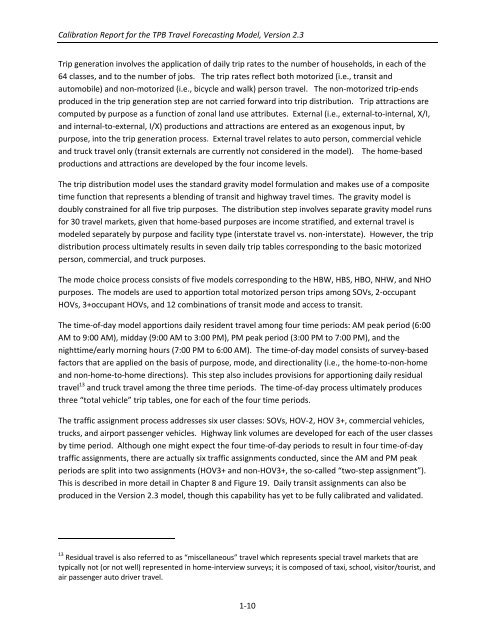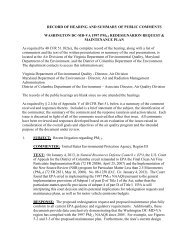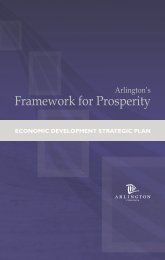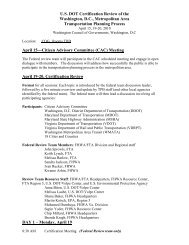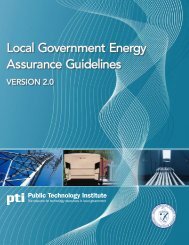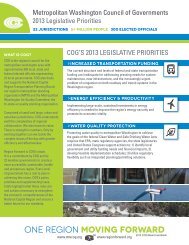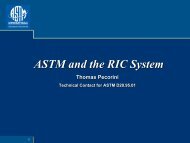Calibration Report for the TPB Travel Forecasting Model, Version ...
Calibration Report for the TPB Travel Forecasting Model, Version ...
Calibration Report for the TPB Travel Forecasting Model, Version ...
Create successful ePaper yourself
Turn your PDF publications into a flip-book with our unique Google optimized e-Paper software.
<strong>Calibration</strong> <strong>Report</strong> <strong>for</strong> <strong>the</strong> <strong>TPB</strong> <strong>Travel</strong> <strong>Forecasting</strong> <strong>Model</strong>, <strong>Version</strong> 2.3<br />
Trip generation involves <strong>the</strong> application of daily trip rates to <strong>the</strong> number of households, in each of <strong>the</strong><br />
64 classes, and to <strong>the</strong> number of jobs. The trip rates reflect both motorized (i.e., transit and<br />
automobile) and non‐motorized (i.e., bicycle and walk) person travel. The non‐motorized trip‐ends<br />
produced in <strong>the</strong> trip generation step are not carried <strong>for</strong>ward into trip distribution. Trip attractions are<br />
computed by purpose as a function of zonal land use attributes. External (i.e., external‐to‐internal, X/I,<br />
and internal‐to‐external, I/X) productions and attractions are entered as an exogenous input, by<br />
purpose, into <strong>the</strong> trip generation process. External travel relates to auto person, commercial vehicle<br />
and truck travel only (transit externals are currently not considered in <strong>the</strong> model). The home‐based<br />
productions and attractions are developed by <strong>the</strong> four income levels.<br />
The trip distribution model uses <strong>the</strong> standard gravity model <strong>for</strong>mulation and makes use of a composite<br />
time function that represents a blending of transit and highway travel times. The gravity model is<br />
doubly constrained <strong>for</strong> all five trip purposes. The distribution step involves separate gravity model runs<br />
<strong>for</strong> 30 travel markets, given that home‐based purposes are income stratified, and external travel is<br />
modeled separately by purpose and facility type (interstate travel vs. non‐interstate). However, <strong>the</strong> trip<br />
distribution process ultimately results in seven daily trip tables corresponding to <strong>the</strong> basic motorized<br />
person, commercial, and truck purposes.<br />
The mode choice process consists of five models corresponding to <strong>the</strong> HBW, HBS, HBO, NHW, and NHO<br />
purposes. The models are used to apportion total motorized person trips among SOVs, 2‐occupant<br />
HOVs, 3+occupant HOVs, and 12 combinations of transit mode and access to transit.<br />
The time‐of‐day model apportions daily resident travel among four time periods: AM peak period (6:00<br />
AM to 9:00 AM), midday (9:00 AM to 3:00 PM), PM peak period (3:00 PM to 7:00 PM), and <strong>the</strong><br />
nighttime/early morning hours (7:00 PM to 6:00 AM). The time‐of‐day model consists of survey‐based<br />
factors that are applied on <strong>the</strong> basis of purpose, mode, and directionality (i.e., <strong>the</strong> home‐to‐non‐home<br />
and non‐home‐to‐home directions). This step also includes provisions <strong>for</strong> apportioning daily residual<br />
travel 13 and truck travel among <strong>the</strong> three time periods. The time‐of‐day process ultimately produces<br />
three “total vehicle” trip tables, one <strong>for</strong> each of <strong>the</strong> four time periods.<br />
The traffic assignment process addresses six user classes: SOVs, HOV‐2, HOV 3+, commercial vehicles,<br />
trucks, and airport passenger vehicles. Highway link volumes are developed <strong>for</strong> each of <strong>the</strong> user classes<br />
by time period. Although one might expect <strong>the</strong> four time‐of‐day periods to result in four time‐of‐day<br />
traffic assignments, <strong>the</strong>re are actually six traffic assignments conducted, since <strong>the</strong> AM and PM peak<br />
periods are split into two assignments (HOV3+ and non‐HOV3+, <strong>the</strong> so‐called “two‐step assignment”).<br />
This is described in more detail in Chapter 8 and Figure 19. Daily transit assignments can also be<br />
produced in <strong>the</strong> <strong>Version</strong> 2.3 model, though this capability has yet to be fully calibrated and validated.<br />
13 Residual travel is also referred to as “miscellaneous” travel which represents special travel markets that are<br />
typically not (or not well) represented in home‐interview surveys; it is composed of taxi, school, visitor/tourist, and<br />
air passenger auto driver travel.<br />
1‐10


